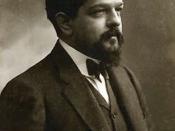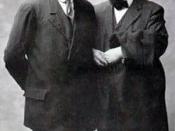Throughout history, art and music have developed in parallel with each other. The impressionist movement is no exception and both of them stemmed from a bold desire to break from traditions in search of new forms of expression. Thus, this essay will explore Impressionism in general, and then further explore features and composers that had a significant influence on musical impressionism. Finally, the discussion will delve into some of Debussy's most significant works as a musical impressionist that contributed to this unique movement.
To begin with, Impressionism in art began in France near the end of the 19th century. It was first used by academic salons in application to painter Claude Monet in an insulting way over the vague mature of his work, Impressions: Sunrise (Machlis, 1980:84). In that painting, others expected to see a realistic picture of a sunrise but were astonished to see what Monet described as "the fugitive changes of nature".
(Howard, 1969:73) Thus, the aim of impressionists was to "suggest rather than to depict; to mirror not the object but the emotional reaction to the object; to interpret a fugitive impression rather than to seize upon and fix the permanent reality" (Thompson, 1937:21). Their chief aim was to produce the general "impression" of the moment made by the subject on the artist. They tended to look at nature with an "innocent eye" (Machlis, 1980:85). Hence, instead of an image of what the painter actually sees, impressionist art substitutes it with the emotional reaction of the artist to the scene he is painting.
Much in the same way, impressionism in music aims to create descriptive impressions, not necessarily to draw clear pictures. A more accurate characterization of impressionist music would include restraint and understatement, a static quality and a provocatively colorful effect resulting from composers' fascination with...



nice
very good effort
0 out of 0 people found this comment useful.